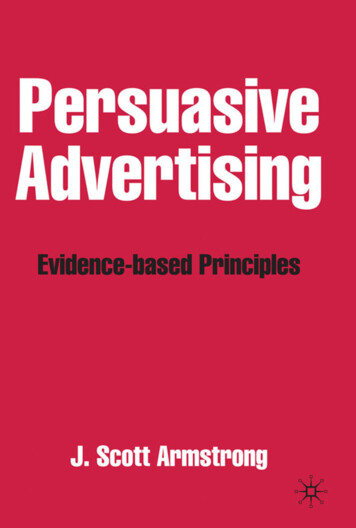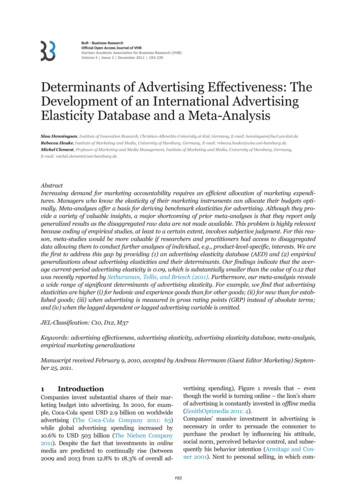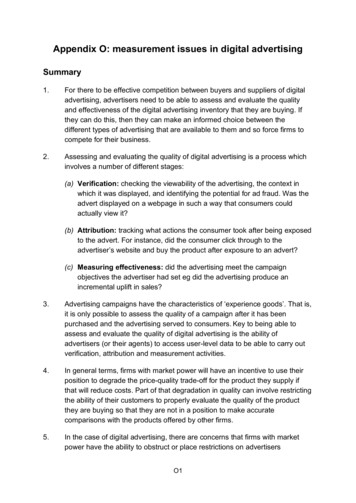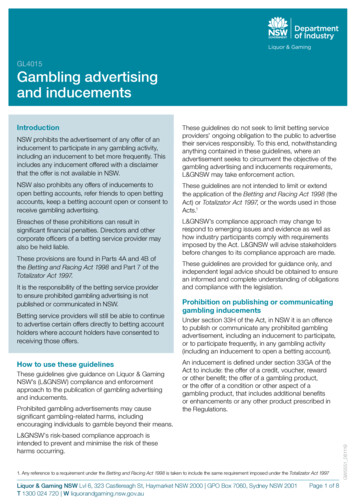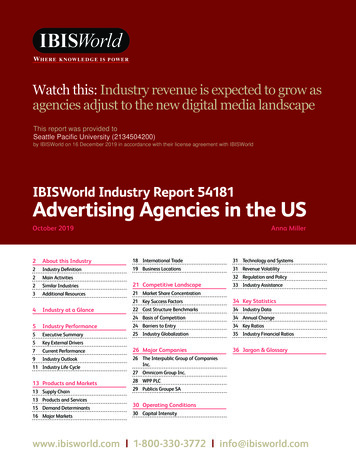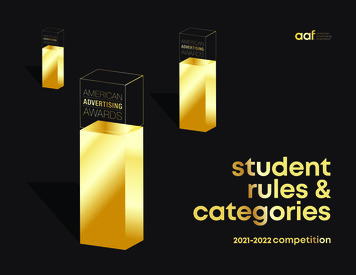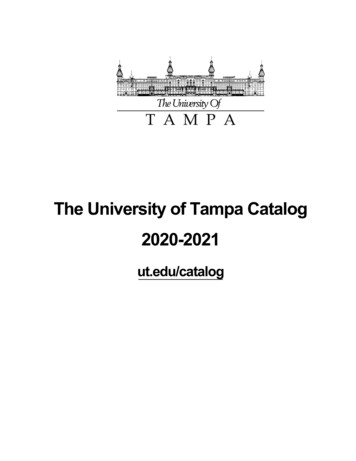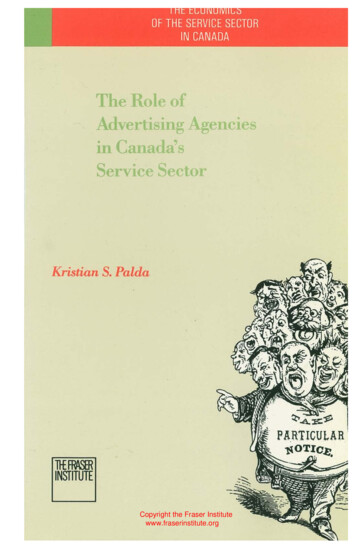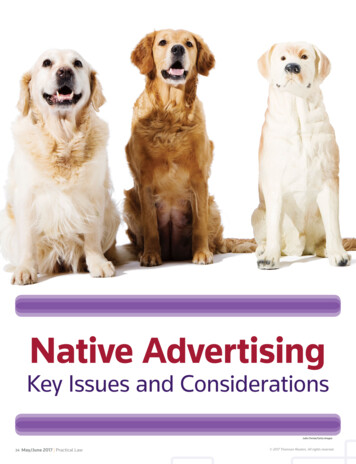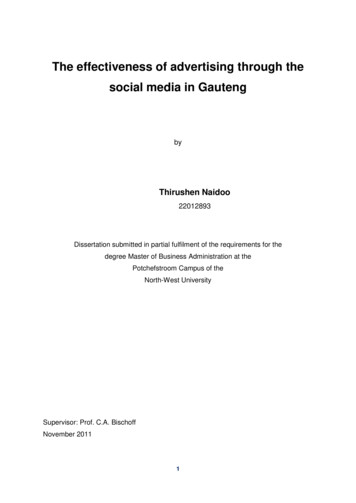
Transcription
The effectiveness of advertising through thesocial media in GautengbyThirushen Naidoo22012893Dissertation submitted in partial fulfilment of the requirements for thedegree Master of Business Administration at thePotchefstroom Campus of theNorth-West UniversitySupervisor: Prof. C.A. BischoffNovember 20111
ACKNOWLEDGEMENTSLord Ganesha, thank you for removing all obstacles in my path to complete thisdissertation.I would like to take this opportunity to express my heart-felt gratitude towards anumber of very special people whose contribution, support and understanding wereessential for the completion of this study. I would like to thank my father Geghia,mother Lavina and two brothers Shalendra and Rishendra for the tremendoussupport through these past three years .To Orisha, a very special thank you for thebelief and encouragement you provided me with during this period of studies. Havingpeople like you in my life has made all of this possible. My heart goes out to eachand every one of you.To Prof. Christo Bisschoff, thank you for the guidance, wisdom and encouragementthroughout the study. You have made this a truly enjoyable experience.“Om Namah Shivaya “2
ABSTRACTIn this day and age, with the very strong impact of globalization, digitalization and social media,advertising is changing. Many companies and advertising role players are forced to implement newconsumer and business models and apply innovative business strategies. Social media marketinghas become a norm for most companies. The process of marketing is used through social media siteslike Twitter, Facebook and YouTube. By utilising the social aspect of the web, social media marketingis able to connect and interact on a much more personalised and dynamic level than throughtraditional marketing.The target audience is a unique generation and has developed a personal filtering system against theonslaught of traditional media. The current idea is to try and build customised relationships with futureclients from a young age, by developing a relationship that complies with their requirements whichsocial media has made a possibility. This study attempts to investigate the effectiveness of advertisingthrough social media, focusing on the social media medium of Facebook to determine the keycorrelations and factors that affect the effectiveness of advertisements on Facebook. The targetaudience utilised is based in the geographical region of Gauteng.A survey was circulated via email to everyday consumers (n 189).Their attitude towards the brandused in the survey, as well as their loyalty to brand, were explored. Descriptive statistics andcorrelations revealed that many factors actually influence one‟s attitude to a brand and the actualeffectiveness of the advertisement. Some trends of interest that were found were the fact that brandsthat have achieved a strong market presence, automatically attain the attention of consumers in theadvertisements. The use of models correlated to the thought processes of consumers also played arole in determining how advertisements are actually perceived. There are four particular constituentsthat contribute to advertising effectiveness on Facebook, namely brand engagement, brand attitude,brand image and consumer engagement. In conclusion, for advertisements to be effective onFacebook, a brand must be established and have a strong brand reputation as the advertisements onFacebook serve to supplement the brand rather than to put the brand up the ranks in terms ofreputation. It is suggested that the survey is reviewed and the study expanded to a less stratified andmore multi-cultural environment.Key terms:Social media, brand image, advertising, Twitter, Facebook, advertising effectiveness,electronic advertising3
ContentsChapter 1 . 9Introduction . 91.1 Introduction . 91.1.1 Facebook . 101.1.2 The impact of Facebook on advertising . 111.2 Problem statement . 131.3 Hypotheses . 131.3.1 Objectives . 141.4 Research methodology . 141.4.1 Literature review . 151.4.2 Research design . 151.4.3 Collection of data . 161.4.4 Data analysis and interpretation of results . 161.5 Problems encountered . 161.6 Demarcation of study . 171.7 Summary. 17REFERENCES . 18Chapter 2 . 18Scientific article . 192.1 Introduction . 192.1.1 Facebook . 202.1.1.2 The impact of Facebook on advertising . 212.2 Problem statement . 232.3 Hypotheses . 232.4 Research methodology . 242.4.1 Literature review . 242.4.2 Research design . 252.4.3 Collection of data . 252.4.4 Data analysis and interpretation of results . 252.5 Literature review . 252.5.1 Advertising Effectiveness . 272.5.1.1 The Classic Hierarchic Model of Advertising Effects . 272.5.1.2 The Two-Route Hierarchic Model for Emotional Commercials and NonEmotional Commercials . 284
2.5.1.4 The Elaboration Likelihood Model of Persuasion . 302.5.1.5 Heuristic-Systematic Model of Persuasion . 322.5.2 Research methodology . 332.5.2.1 The Sales Effect . 352.5.2.1 The Communication Effect . 352.5.2.1.1 Sociological . 362.5.2.1.2 Semiotic Objective . 362.5.2.1.3 Psychological . 372.5.2.1.4 Socio-psychological . 372.5.3 Facebook . 382.5.3.1 Facebook overview . 402.5.3.2 The Facebook Ecosystem. 422.5.3.4 Classified advertising on Facebook: . 432.5.3.5 Banner advertisements: . 442.5.4 Encouraging brand advocates: . 442.5.4.1 Personalization . 462.5.4.2 Comprehension . 462.5.4.3 Satisfaction . 472.5.4.4 Trust . 482.5.4.5 Persuasion . 482.5.4.6 Quality of decisions . 492.5.4.7 Sales and return reduction . 492.5.4.8 Brand equity . 502.5.5 The major financial advantages of advertising on Facebook: . 502.6 Results . 512.6.1 Cronbach's Alpha . 512.6.2 Demographic profile . 522.6.3 Mean values. 572.6.3.1. Average mean values . 602.6.4 Advertisements . 612.6.5 Type of advertising . 632.6.6 Correlation Coefficients . 642.6.6.1 Correlation Coefficients for the Personal Profile . 652.6.6.2 Correlation Coefficients for the Advertising Personality . 662.6.6.3 Correlation Coefficients for Consumer Engagement . 685
2.6.6.4 Correlation Coefficients for Brand Reputation . 692.6.6.5 Correlation Coefficients for Brand Attitude . 702.7 Conclusions . 712.8 Recommendations . 722.9 Summary. 73References. 74Chapter 3 . 79Conclusions and recommendations . 793.1 Introduction . 793.2 Conclusions . 793.3 Recommendations . 813.4 Areas for future research . 813.5 Summary. 82References. 84Addendum .Error! Bookmark not defined.Addendum A: Survey Electronic Format . 89Addendum B: The Survey questions and answers . 90Addendum C: Mean Values and Percentages: . 996
List of TablesTable 1: Figures of Facebook users . 39Table 2: Gender Segmentation of Facebook Users . 39Table 3: User Age Segmentation of Facebook Users . 40Table 4: TOP 5 Facebook brands in South Africa (May 2011): . 40Table 5: Cronbach‟s Alpha . 52Table 6: Results of the demographic variable: Facebook Profile . 53Table 7: Results of the demographic variable: Gender . 53Table 8: Results of the demographic variable: Log on Period . 53Table 9: Results of the demographic variable: Age Group . 54Table 10: Results of the demographic variable: Time Spent on Facebook . 55Table 11: Results of the demographic variable: Race Group . 55Table 12: Results of the demographic variable: Education Status . 56Table 13: Results of the demographic variable: Language Group . 56Table 14: Mean values . 57Table 15: Average of Means and Standard Deviations . 60Table 16: Mean Averages . 61Table 17: Choice of Advertisements. 62Table 18: Times Advertisement Viewed . 63Table 19: Correlation of Personal Profile Questions. 65Table 20: Advertising Personality . 66Table 21: Consumer Engagement . 68Table 22: Brand Reputation . 69Table 23: Brand Attitude. 707
List of FiguresFigure 1: Diagram of Research Methodology . 15Figure 2: The Classic Hierarchic Model of Advertising Effects . 27Figure 3: The Two-Route Hierarchic Model for Emotional Commercials . 29Figure 4: The Two-Route Hierarchic Model for Non - Emotional Commercials . 29Figure 5: The Elaboration Likelihood Model of Persuasion . 31Figure 6: Diagram of Heuristic-Systematic Model of Persuasion . 32Figure 7: Diagram of Research Items. 34Figure 8: Facebook Overview . 41Figure 9: Facebook Groups. 41Figure 10: Facebook Marketplace . 43Figure 11: Summary of the Mean . 618
CHAPTER 1INTRODUCTION1.1INTRODUCTIONAdvertising appeals aim to influence the way consumers view themselves and howbuying certain products can prove to be beneficial to them. The message conveyedthrough advertising appeals, influences the purchasing decisions of consumers. Akey to social media is that the consumer-generated content and consumer-fortifiedcontent can also influence image (Marland, 2008). The viral nature of brand-relevantcommunication is why social media is both an opportunity and a threat foradvertisers. To determine the relative influence and nature of that influence on abrand, one must consider the source of content, the relative authority of that source,and the content itself.Marketing is essential to most businesses and is generally the most important aspectof any business strategy. Many large companies in South Africa spend millions ofrand on marketing their businesses whereas smaller companies are more reliant onmore creative and cost effective methods (Godin, 2008). In the extremelycompetitive world we live in today, social media marketing has become the newtrend and is a trend that is here to stay by means of using social media such asblogs, community sites, video sharing sites etc. to market a product or a business.The popular websites such as Facebook, Twitter, and YouTube have close to fivemillion visitors daily and thus have to be considered as a very important hub formarketing (Sarah E Needleman, 2011). Promoting a business via these sites servesas a very attractive business proposition due to the vast amount of steady trafficevery day. Today's vast technological advances have made social networking to beextremely successful and social media marketing a very important segment in abusiness, because of the sheer number of people that access these sites regularly.The advertising in social media differs from the traditional product and servicemarketing, in that it does not depend on a mere unidirectional relationship betweenthe advertiser and the consumer. A successful social media advertising campaign is9
designed to create a buzz. Social media advertising is an entity that works along acontinuum that is ever-evolving. The successes of campaign advertisements relyentirely on the marketer‟s ability to entice social network users to discuss andpromote a product.The power of advertising is underestimated. Advertising has the power to persuade,the power to influence the mind and to shape destiny. It has the power to changemarkets and improve profit margins. Advertising has both short-term power and longterm power. In short-term power advertising conveys new information, buildsawareness and enhances credibility (Robin Neifield, 2010). With respect to long-termpower, the advertisement conveys brand image, promotes emotional values to thebrand, and builds a positive reputation. The potential that advertising offers is far toogreat to ignore. The great power of advertising is seldom achieved in practice, simplybecause organizations do not know how effective there advertising really is. Thecompanies that master the creative guidance that allows for advertising to succeedconsistently develop and deploy - great advertising will own the future and thefortunes that go with it. Effective advertising is the key to success and thesustainable competitive advantage that all companies are looking for.There are a vast number of social media sites that could be used for advertising;however the social media medium chosen for this study, is Facebook. The reason forthis is that Facebook is the most popular social media website on the Internet. Thefollowers that Facebook has accumulated in South Africa is the highest from all theSocial Media mediums available around the globe. Facebook was launched inFebruary 2004. As of 2010, Facebook had over 500 million users (Social Bakers,2011).1.1.1 FacebookFacebook is among the highest profiting sites on the web, weighing in at a projectedvalue of ten billion dollars (Foe, G. 2010b).The reason why Facebook has reachedsuch popularity is simply because it opens people to free lines of communicationbetween genders across the world or across the street, in a real time andasynchronous way blending marketing, opinions and suggestions and gamesperfectly for several minutes of relaxation away from the problems of the world.10
Facebook is an exceptional marketing and advertising tool for people searching toget a product concept which is either virtual or physical, out. Facebook has anadvanced campaign setup that allows companies to pick a specific demographicregion, which means that they can target products to specific individuals living in aparticular geographic area. This method of audience targeting is facilitated byresearch on demographics.Whilst you move within your journey from basic to advanced attributes in Facebookmarketing, it is possible to take support from a lot of tools. Marketing and advertisingby means of Facebook without any tools, is like attempting to take care of a farm byworking with hand tools. There are tools on Facebook that will enhance the efficiencyof advertisements on the medium.Facebook is becoming a lot more profitable every day, especially with all thepossibilities accessible for advertising on this social media medium. Facebookmarketing software program permits you to automate and target the method ofbefriending individuals and exposing your group to a fan page for big crowds (RobinNeifield. 2010). The use of Facebook advertising is giving organizations acompetitive edge which is needed to sell their products and services.1.1.2. The Impact of Facebook on AdvertisingOrganizations can benefit from advertising in Facebook space. Facebook offersadvertisers opportunities.Engaging consumers - Facebook makes it more easy and flexible when it comes toengaging with customers. Customer engagement is the most important benefit ofFacebook marketing and therefore helps to retain existing customers and alsoincrease brand credibility. During the recent economic downfall, a lot of companiessucceeded in retaining their customers with the help of customer engagementthrough Facebook.Enhancing brand reputation and image - companies can use Facebook as a way ofincreasing their goodwill and trustworthiness, which may ultimately result in better11
branding. Companies are enabled to make conversation with its customers, whichresults in a great amount of credibility among its customers.Build positive brand attitudes - there are many factors that influence Facebookadvertising including the mood of the consumers when influenced by advertisement,their history with the company or brand and whether the information entered intotheir profile is really accurate. These factors can simply be boiled down to the brandattitudes consumers have towards the marketer. Facebook enables you to foster andbuild a positive brand attitude towards products of the advertiser.Enhance Customer Relationship Management - customer relationship is an integralpart of the growth of any company and when customer relationship fails, thecompany and its operations are also bound to fail. Facebook channels assist bymaking strong bonds between the customer and the company much easier andthereby increasing the stability of the company. Facebook allows you to know moreabout the trends and preferences of the customers and act accordingly. Customerpreference can also be related to the points mentioned above. Knowing thepreferences of your customers make it easier for you to enhance your product andplan one‟s online marketing campaigns in a much more effective way.Announcing new products or services - there is no other better and cheaper mediathan Facebook to inform your customers about the arrival or release of new productsand services. Facebook creates a platform that allows for easier spread of newproduct and service arrivals to a targeted audience.Facebook advertising is one of the most trending subjects in online marketingnowadays and from the importance listed above, it is easy to understand thereasoning behind this. Many organizations strive to engage themselves intoFacebook for various purposes. The reasons for organizationsturning towardsFacebook advertising is dependent on various factors, such as the company profile,the products, and customers (Bernoff, 2008).The day by day importance of effectiveFacebook advertising is on the rise for almost all the companies.The steps in a Facebook advertising campaign will begin with setting the campaignobjectives and end with assessing the effectiveness of the strategies and tactics, in12
order to determine the degree of success in accomplishing the stated objectives andto inform the next campaign. The challenge with Facebook advertising is actuallymeasuring the effectiveness of the advertisement‟s key to Facebook in that theconsumer-generated content and consumer-fortified content can also influenceimage. The viral nature of brand-relevant communication is the reason whyFacebook is both an opportunity and a threat for advertisers.1.2PROBLEM STATEMENTThere are many statistics that are applicable and available for the use of advertisingin the Facebook space. Statistics like number of unique visitors, page views, andfrequency of visits, average visit length, and click through rates are either totallyunsuitable or irrelevant. This reflects a basic failure to capture information about theeffectiveness of the Facebook advertisement. These statistics are merely a count ofimpressions, visitors, friends, posts and players. This counting does not capture theessence of the interaction consumers had with the brand, the degree of engagementfelt during and after the interaction, or the effects of the interaction, exposure tobrand messages, and brand engagement on measures like brand likability, brandimage, brand awareness, brand loyalty, brand affiliation, congruency, and purchaseintent. To measure the effectiveness of social media advertising, there should be abalance between quantitative statistics with qualitative insights that cannot be gainedfrom simple statistics that are on offer.1.3HYPOTHESESThe research hypotheses will emanate from possible factors that contribute to theeffectiveness of Facebook advertising. To test the effectiveness we will have tomeasure:Customer engagement;Brand reputation and image;Products and services being offered to the customer;Customer brand attitude.13
1. There is a sole factor that has an effect on the advertisement.2. There is a correlation between two factors that has an effect on theadvertisement.3. There are various numbers of factors that have an effect on theadvertisement.1.3.1 ObjectivesThere are two objectives that have been identified:To study the impact that the variables used in the study has on theeffect of advertising on Facebook.To investigate the relationship these variables have with each other onthe overall effects on advertising on Facebook.1.4RESEARCH METHODOLOGYThere are four phases to the research methodology used, which consists of:Literature review;Research design;Collection of data;Data Analysis and interpretation of results.14
Figure 1:Diagram of research methodologyPhase 1 : Literature reviewPhase 2 : Research designPhase 3 : Collection of data, the useof the measurent instrumentPhase 4 : Data analysis andinterpretation of results1.4.1 Literature reviewThe literature review was conducted via the effective evaluation of selected journalsand articles on effective adverting in the social media area based on criticalsynthesis. This review forms an essential part of the research that is carried out. Theliterature review produces the background for the study. The evaluation of theliterature logically leads to the answers required. The literature review served as aprecursor to the research, and was a critical and in depth evaluation of previousresearch. The models used to formulate the hypothesis are discussed in more detail.1.4.2 Research designThe research will follow an anti-positivist approach. This study will allow us to identifythe important variables in our study that will lead to meaningful hypotheses. Thisforms a descriptive design that will track behaviour amongst individuals that fall into15
our sample. This study forms an exploratory study as the investigations still are inthe early stages.1.4.3 Collection of dataData is the gathered information that had been collected from the literature studies.The key factors were used to structure a survey. The survey consisted of theidentified factors with specific criteria that had been able to evaluate each factor. Theviews of the respondents were captured by a 7 point Likert scale, as this producesmore accurate results, when compared to a 5 point Likert scale.Cronbrach‟s Alpha was calculated to ensure the volatility and internal stability of
advertising is changing. Many companies and advertising role players are forced to implement new consumer and business models and apply innovative business strategies. Social media marketing has become a norm for most companies. The process of marketing is used through social media sites like Twitter, Facebook and YouTube.



